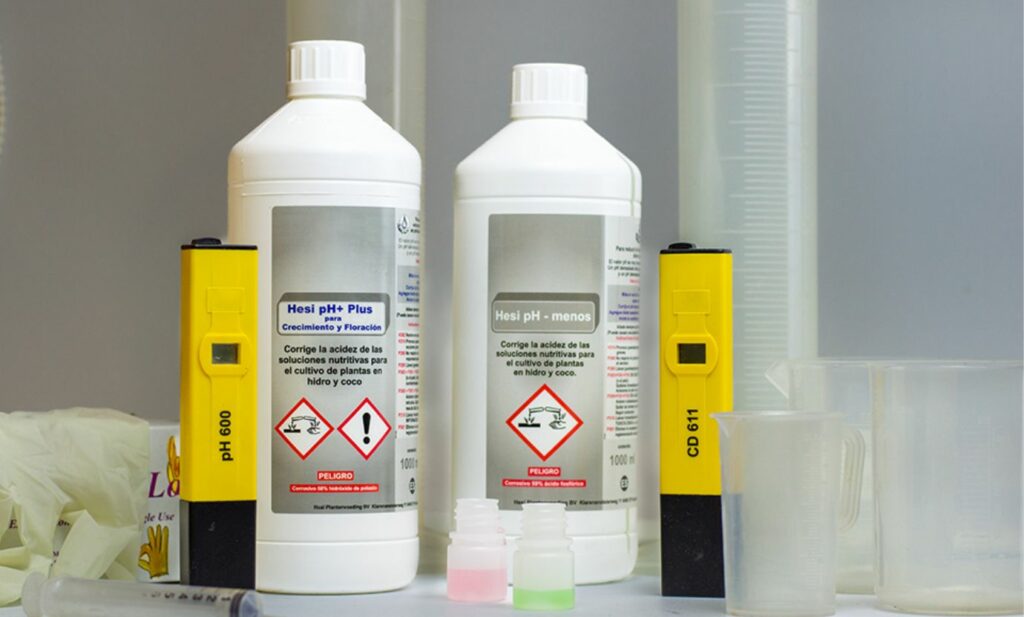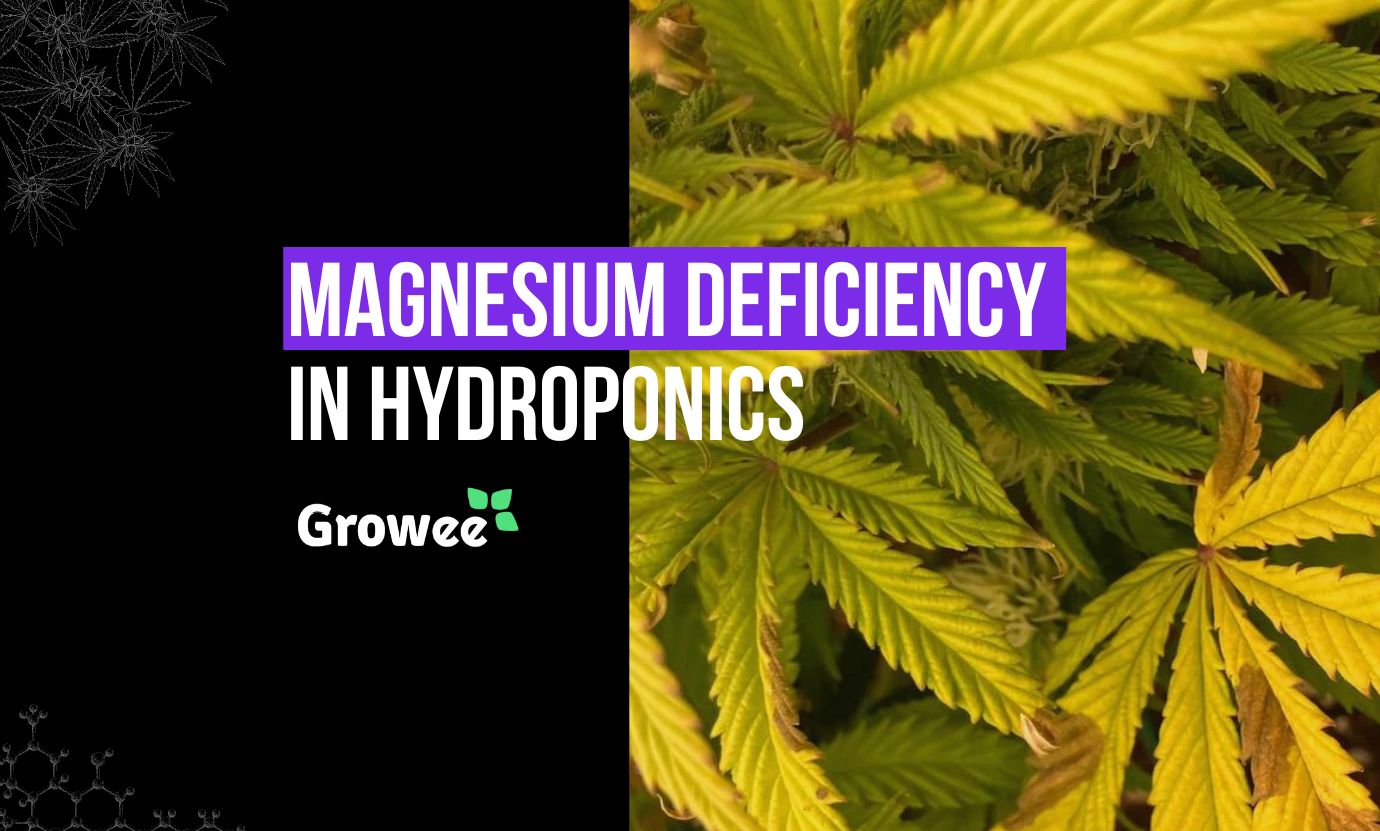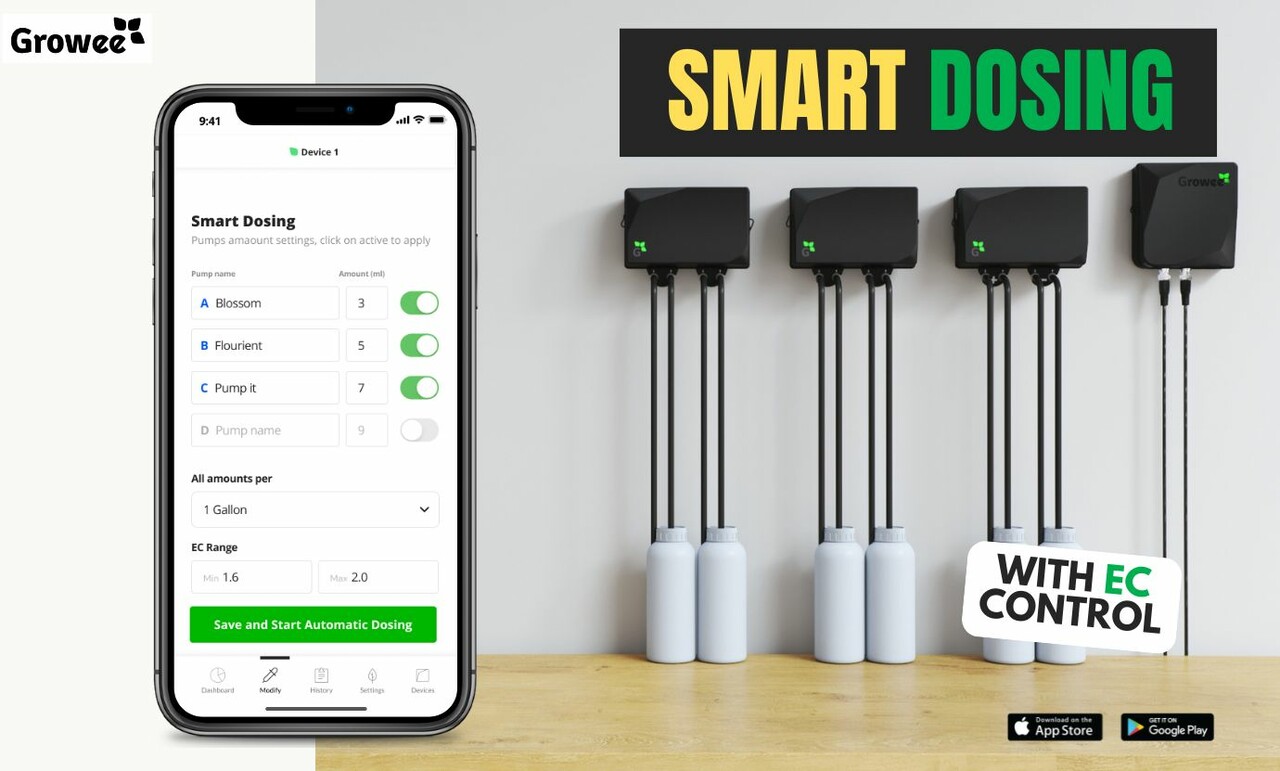Plants need a mix of nutrients to grow healthy and strong, in hydroponics you can control the amounts of nutrients that are provided to the plants, “nutrients” or “fertilizers” are made of a mix of different elements where each elements play a crucial role in plant health and development.
To make it simple, we will divide the elements into 3 main groups, The big three, known as primary macronutrients, are nitrogen (N), phosphorus (P), and potassium (K). Then there are secondary macronutrients: calcium (Ca), magnesium (Mg), and sulfur (S), which plants need in smaller amounts. Additionally, the last group is micronutrients: Iron (Fe), Manganese (Mn), Copper (Cu), Zinc (Zn), Boron (B), Molybdenum (Mo), Chlorine (Cl), Nickel (Ni). Overall 14 essential elements that plants typically absorb from fertilizers.
Magnesium deficiency is a common but easily missed problem in plants, Although magnesium isn’t one of the primary nutrients like nitrogen or potassium, it’s crucial for photosynthesis and overall health.
Today, we want to determine what a magnesium deficiency in your hydroponic plants looks like, what caused it, and what you can do about it.
Magnesium (Mg) or Manganese(Mn)? Clearing Up Confusion
Magnesium (Mg) and manganese (Mn) may sound alike, creating confusion among both new and experienced growers, but they’re distinct elements with unique roles in plant health.
Magnesium is integral to chlorophyll, giving plants their green color and helping convert sunlight into energy.
Manganese, though needed in lesser amounts, is crucial for photosynthesis and efficient nutrient use. This article will focus specifically on magnesium (Mg) deficiency, exploring its impact and management strategies.
See How Growee Can Save You Time By Automating Your Plants Feeding
Water pH – Automated pH Up and Down Control
Nutrients Mixing – Automated Nutrient Dosing with Target EC / PPM Control.
Control From Anywhere – WiFi Connection and mobile App
How To Add Magnesium To Your Hydroponic Water Solutions

Many small-scale hydroponic growers rely on off-the-shelf pre-mixed hydroponic nutrients from well-known companies. While liquid nutrients are the most common form, some companies also offer powders, for more information about the differences between powder and liquid nutrients, read our article: Using Dry Soluble Powder Vs Liquid Fertilizers in Hydroponics.
It’s important to note that these nutrients often come in separate solutions, tailored to provide plants with the specific elements they need.
For example, in the General Hydroponics Flora Series, the base pack has three different fertilizer bottles, also known as 3 parts nutrients, each part contains different elements, including Magnesium.
The FloraGro contains 0.5% water-soluble magnesium (Mg), while FloraBloom provides 1.5% water-soluble magnesium (Mg). Floramicro does not contain magnesium.
Most growers will prefer to use the feed chart provided by the company is essential to prevent nutrient imbalances and ensure optimal plant growth. For more information about mixing nutrients in hydroponics check out our article: Mastering Hydroponic Nutrient Solutions: A Step-by-Step Guide
What Causes Magnesium Deficiency in Hydroponic?

In hydroponic systems, a magnesium deficiency in plants often arises from insufficient magnesium available to the plants. Several factors contribute to this deficiency. Here, we explore three primary reasons why your plants may suffer from a lack of magnesium
Incorrect pH Levels:
The absorption of magnesium by plants is highly pH-dependent. If the pH of the nutrient solution is too high or too low, it can hinder the plant’s ability to absorb magnesium effectively. For more information about the effect of pH in hydroponics, click this link.
Competition from Calcium and Potassium
Magnesium, calcium, and potassium are all absorbed by plants through the same transport mechanisms in their roots. If your nutrient solution calcium and/or potassium concentration is too high, these nutrients can indeed outcompete magnesium for uptake, leading to a deficiency even when adequate magnesium is present
Magnesium is needed for plants to engage in photosynthesis
Magnesium plays a crucial role in photosynthesis as it is a central component of the chlorophyll molecule. When light intensity is high, plants engage more actively in photosynthesis and thus require more magnesium. If the supply doesn’t meet this increased demand, deficiency symptoms can occur.
How to Tell If Your Hydroponic Plants Need More Magnesium
If you are growing your own plants at home, whether cannabis or otherwise, and you notice any one of the following signs, spotting magnesium deficiency in your plants can be tricky, but it’s essential for their health and growth. By knowing what to look for, you can identify the signs and take action to support your plants.
Symptoms of Magnesium Deficiency:
- The most common symptom is yellowing between the veins of older leaves, while the veins stay green (interveinal chlorosis).
- If you notice necrotic spots and the leaves curling upwards, this is another classic sign of a magnesium deficiency.
- If your crop grows slowly, is small and stunted, and is producing a lower-than-average yield, it may also be a result of a lack of magnesium.
Treating a Lack of Magnesium
So, if your plants are suffering from a magnesium deficiency, how do you deal with this?
Adjust the Nutrients
To treat a lack of magnesium in your cannabis crop, or other hydroponic plants, the best thing that you can do is to adjust the nutrient solution to contain more magnesium. You may also need to cut back on calcium and potassium, even just slightly, as this can increase the absorption of magnesium. Of course, being able to accurately measure nutrient levels is crucial to get this right, something that Growee products can certainly help with. Some companies are offering special supplement that you can add to the nutrients solution, the most common one is Cal-Mag, a calcium-magnesium supplement.
Adjust the pH
If you notice that the pH level is outside the ideal range (5.8 to 6.5), then you need to take the appropriate steps to adjust it to fall within that range, with 6.0 usually being considered best. You may need to use pH+ or pH- products to achieve this, along with other methods. One thing to take note of is that adding more magnesium into the nutrient solution will automatically raise the pH level.
How to Prevent Magnesium Deficiency
The best way to prevent a magnesium deficiency from occurring is to monitor the pH level on a regular basis, because the pH needs to fall within the optimal range for maximum magnesium absorption. Having the right pH is essential, and to that end, the right monitoring equipment can be very useful.
Next, just make sure that you are using a balanced nutrient solution. If you are growing cannabis, make sure to use a hydroponic nutrient solution specifically designed for cannabis, and ensure that it contains significant levels of Mg.
How do Growee Products Prevent Magnesium Deficiency?
Simply put, Growee products measure nutrient levels and then automatically adjust your solution for you, without you having to do any calculating or heavy lifting yourself. Even better is that by using the Growee App, you can set a feeding schedule. You can just set and forget, so Growee automatically feeds your plants even if you aren’t there physically.
Using the Growee pH Controller to Automatically Adjust Water pH
Ensuring the right pH level for your hydroponic plants is crucial to prevent magnesium deficiency. However, maintaining pH can be challenging due to various factors like root uptake and nutrient additions and water changes or top-offs, this makes keeping the pH on spot almost impossible, especially if you are using a batch tank or mixing the nutrient solution on a daily basis
The Growee smart pH controller, a Wi-Fi connected automated device, monitors pH levels and adjusts them as needed by adding pH up or down solutions. This helps avoid magnesium deficiency in hydroponics effectively.
Adding Magnesium Automatically Using The Growee Automated Doser
Using the Growee automated nutrient doser ensures precision and accuracy in nutrient delivery to your hydroponic solution. This is especially beneficial when following complex feeding charts with multiple base nutrients and supplements.
For instance, in the General Hydroponics Flora Series example, if you’re using the “Professional 6-Part Nutrient System” feed chart, you need to add base nutrients (Flora Micro, Flora Bloom) and supplements (Cal Mag, Floralicious Plus, Liquid KoolBloom) separately and in specific ratios to prevent deficiencies like magnesium deficiency.
The Growee Hydro Master + x3 Growee Nutrient dosers (with x6 dosing pumps) will monitor the water TDS and injects nutrients automatically, maintaining EC/TDS/PPM within desired ranges. The Growee system will make sure your plants get the right amount of magnesium with precision and saves you time
Conclusion
At the end of the day, the reality is simple. If your plants aren’t getting enough magnesium, you’re going to run into some problems, mainly heavily stunted growth and drastically reduced yields. However, by constantly monitoring and adjusting magnesium and nutrient levels, an Mg deficiency can be avoided, something that Growee products take care of for you.
FAQ
What Role Does Magnesium Play in Hydroponics?
Magnesium is essential for both photosynthesis and chlorophyll production in plants. It also helps produce bigger yields with higher potency.
How Quickly Will My Plants Recover from Magnesium Deficiency?
If you take all of the appropriate steps, a plant may recover from a magnesium deficiency in as little as 1 to 2 weeks.
How Can I Avoid Mg Deficiency?
You can avoid a magnesium deficiency by constantly monitoring the pH and EC levels, as well as the hardness of your tap water. You can use special tools like those from Growee, that do all of the hard work for you
Which Signs Indicate That a Plant is Lacking Magnesium?
Yellowing of the leaves in between the veins, stunted growth, lower yields, and the upward curling of the leaves are all indications of a magnesium deficiency in plants.
What Happens When Plants Lack Magnesium?
If a plant is lacking in magnesium, it won’t grow as tall or as fast, it won’t be able to perform photosynthesis as well, and ultimately, the yield will be much lower and less potent.
How Do You Fix Magnesium Deficiency in Hydroponic Plants?
The simplest way to fix a magnesium deficiency in plants is to add more magnesium into your nutrient solution.
What is the Best Way to Correct an Mg Deficiency in Plants?
If you need to quickly correct a magnesium deficiency, a combination of adding magnesium into the nutrient mix with a magnesium foliar spray is recommended.
How Does Using the Growee pH Controller for Balancing the pH of the Water Help with a Magnesium Deficiency?
The Growee pH Controller helps to maintain the pH levels within the ideal range, which therefore allows the magnesium to be more available to your plants.





